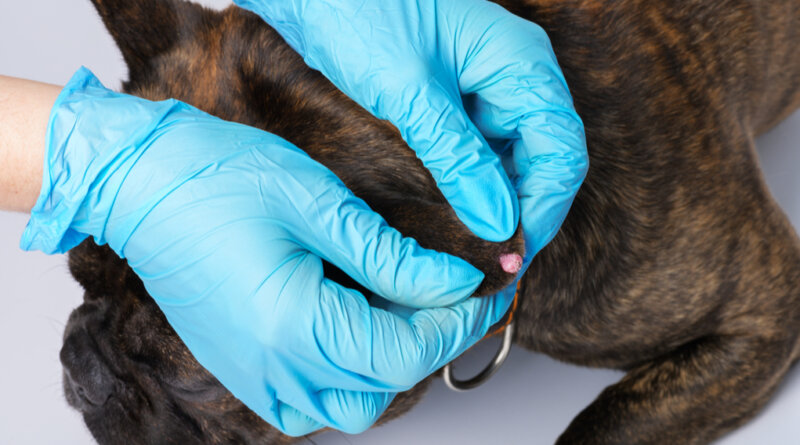Canine Papillomavirus and What to Watch Out For
Canine papillomavirus is a viral wart that appears in the mouth. It is a viral disease and is highly transmissible from dog to dog.
The virus is present in the papillomas, and the infection can spread by direct contact with the papilloma in an infected dog’s mouth.
What Is Canine Papillomavirus?
Canine Oral Papilloma, also known as oral warts, are small and benign mouth tumors caused by the papillomavirus. These warts are primarily on the lips, gums, mouth, and mucous membranes.
Multiple papillomas are generally in young dogs and puppies because these dogs’ immune systems are not yet ready to fight off the virus.
On the other hand, single papilloma is more common in older and senior dogs.
How Are Canine Papillomavirus Diagnosed?
Most of the time, the diagnosis of papillomavirus is through inspecting for any viral warts. The groups of cauliflower-like sores are very recognizable due to their unique appearance, found in and around the mouth.
In some instances, warts may bleed and swell. Behavioral changes in dogs are visible, like having trouble eating, especially if the pain is too much to handle.
Our canine friends will become asymptomatic unless the sores become infected by a bacterium in the mouth. If this happens, your dog may need antibiotic treatment.
Your veterinarian may advise a biopsy to confirm the diagnosis.
How Is Papillomavirus Transmitted?
The transmission of this virus is through direct contact with the papillomas on an infected dog or with the virus in the pet’s surroundings, e.g., toys, beddings, food bowls, etc.
The virus requires injured skin to establish the infection because it cannot infect healthy skin. The incubation period will last up to 2 months and can only spread among dogs.
Papillomavirus is not contagious to other pet species or humans and also not infectious after the regression of the lesion.
Recovered dogs will not get sick again with the same strain of the virus but know several other kinds.
Infection in canines occurs when a dog has a weak immune system and is usually with puppies and younger dogs. Dogs that take cyclosporine orally to treat autoimmune diseases may experience a papillomavirus outbreak.
Symptoms and Causes of Papillomavirus in Dogs
Symptoms
- Has papillomas or viral warts
- Bad breath
- Swelling in or around the mouth
- Eating discomfort
Causes
The canine papillomavirus type I develops by:
- Compromised immune system
- Long-term usage of corticosteroid treatment
- Weak immune system due to genes
- Age (puppies, younger dogs under two years old, and elder dogs)
What Does Papillomavirus in Dogs Look Like?
The most common canine papillomavirus is near the mouth because of the CPV1 (Canine Papilloma Virus-1). Viral papillomas are round, often rough, and have a cauliflower-like appearance.
Papillomavirus usually occurs on the eyelids, eye surface, or between the toes. These viral warts appear in groups rather than solitary growth, so check inside the mouth and lips if there’s one visible growth.
Does My Dog Have Warts?
Some viruses cause the growth of small round skin tumors, otherwise called warts.
It is essential to know that viral warts are a specific condition, and their growth on the dog’s skin may or may not be a viral wart. Before assuming that growth is just a wart, it’s good to research more about it.
In dogs, the form term for warts is viral papilloma. Same as humans, a viral papilloma is due to papillomavirus.
Although dogs and humans have different papillomavirus, the virus cannot transmit across species lines.
A canine’s viral wart tends to have frond-like structures that create more of a cauliflower-like appearance and can be smooth in texture.
Is Canine Papillomavirus Dangerous?
Canine papillomavirus is not entirely dangerous. It goes away on its own as the dog’s immune system strengthens and generates an immune response against the virus.
The regression will only take 1 to 2 months. If the infection is still there after three months, treatment and biopsy may be required to confirm that the wart is a viral papilloma.
Severe cases may interfere with your pet’s chewing and swallowing. Sometimes oral papillomas can infect the mouth with bacteria.
In most cases, the prescription of antibiotics can control the pain, swelling, and bad breath.
How to Cure It?
Treatment for this condition is mainly in an outpatient setting. However, in severe cases, surgery is the option.
Outpatient Treatment
It’s essential to observe warts and see if it bleeds, increased in size, or caused discomfort to dogs. But as the immune system improves, a response will most likely resolve the infection.
Most papillomas or warts heal themselves and will go away within 2-3 months.
If there’s an occurrence of a healthy immune response, your dog has a higher chance of not getting the same strain of virus again.
Inpatient Treatment
If the papilloma warts are visibly large, the dog may need surgery. The veterinarian will remove warts, culture for any infection, and analyze to ensure there is no malignancy.
Prescription medicines may be essential to reduce the pain and swelling caused by a bacterial infection.
Interferon-alpha treatments can be another option, but it is expensive. These treatments help stimulate your dog’s immune response to papillomavirus and are usually two to three times per week.
How to Prevent It?
The virus can survive for at least two months at four °C, but only for 2 hours at 37°C. Since the papillomavirus can spread on toys, food bowls, and beddings, it is advisable to clean your dog’s environment and belongings thoroughly.
It is much better to soak these belongings in hot water and detergent to kill the virus that lingers in them possibly.
Canine papillomavirus is highly infectious, so it’s better to keep your puppies and immunocompromised dogs away from any canine showing papillomavirus symptoms.
On the brighter side, as the virus subsides on your dog, it is no anymore contagious to another canine.
Different Types of Canine Papillomavirus
Although single development is also possible, canine papillomavirus appears as a cluster of multiple growths. Here are three types of papilloma warts found in dogs:
- Canine Mucous Membrane Papillomatosis – Commonly affects the lips and mouths of young dogs. This type can also affect the skin around the eyes and appears while growing and spreading very quickly.
- Cutaneous Papillomas – Appear frequently as single growths in older dogs.
- Cutaneous Inverted Papillomas – Usually seen in young adult dogs. The most common growth is on the underside of the abdomen and can also occur in the feet.
Canine Papillomavirus Key Takeaways
- Oral papilloma warts are small benign tumors in the mouth caused by papillomavirus type 1.
- These viral warts are transmissible through direct contact with an infected dog or through their food bowls, toys, and beddings. The virus can’t go to humans or other animal species.
- In most cases, treatment is not recommended for canine papillomavirus because it can heal on its own after a few weeks. However, if the viral warts are still there after three months, the veterinarian will perform a biopsy to confirm that the warts are indeed papillomas.
- Always speak to your veterinarian for any suspicious warts on your dog’s mouth. They are the best person to go to for your pet’s overall health.
Related








